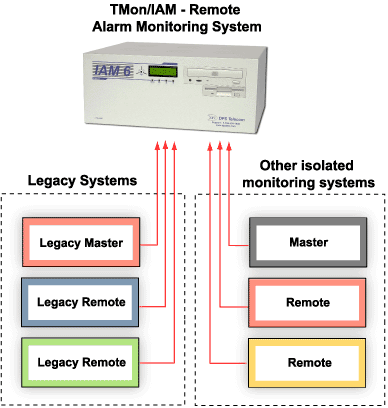Check out our White Paper Series!
A complete library of helpful advice and survival guides for every aspect of system monitoring and control.
1-800-693-0351
Have a specific question? Ask our team of expert engineers and get a specific answer!
Sign up for the next DPS Factory Training!

Whether you're new to our equipment or you've used it for years, DPS factory training is the best way to get more from your monitoring.
Reserve Your Seat TodayRecently, we had the opportunity to assist a publicly traded diversified energy company that was facing significant challenges with their existing network monitoring systems. They needed a solution that could integrate their legacy equipment with new network management systems (NMS) while maintaining secure communication channels and ensuring timely notifications for critical alarms.
Let's look at the issues they faced, the shortcomings of their previous attempts to solve these problems, and how a full comprehensive solution ultimately met their needs.

Our client's existing setup was struggling with compatibility issues, which required them to use several different interfaces and tools to monitor their entire network. This fragmentation caused inefficiencies and increased the risk of missed alarms. That can have severe consequences for any utility. Given enough time, it will always become a problem for you.
As their network operations center (NOC) staff had to switch between different systems to get a complete picture of network health, response times were slowed. The chances of human error increased.
In your critical-infrastructure environment, every second counts. These problems posed a significant risk to reliability and, ultimately, public health and safety.
The client was also concerned about the security of their network. They needed to allow specific ports through their firewall for monitoring systems without compromising their security protocols. Unfortunately, their existing solution lacked the ability to provide detailed guidance on how to configure these settings effectively. This complicated the situation and left the network vulnerable to potential threats.
Their IT and security teams were particularly concerned about the potential for unauthorized access through improperly configured ports. Without clear instructions and support, the risk of opening the wrong ports or failing to secure them adequately was too great to ignore.
To address these challenges, the client had been relying on outdated software that required manual installations for firmware updates. This process was time-consuming, prone to errors, and increased the risk of operational disruptions.
Manual firmware updates required the NOC staff to take equipment offline, potentially disrupting critical monitoring functions. The process was also complex and required specialized knowledge, which meant that updates were often delayed until the right personnel were available. In a fast-paced environment where network conditions can change rapidly, these delays and errors could lead to missed alarms and preventable incidents.

The client also attempted to use external cellular boxes to send SMS alerts, but this setup was difficult to use and lacked the reliability they needed for critical notifications. Their system also required multiple points of interaction for monitoring different parts of their network. This need increased the potential for oversight and made it difficult for operators to get a complete picture of the network's status.
For a network that spans multiple sites and includes a variety of equipment types, having a reliable and straightforward alarm notification system is essential. The client's existing setup was not only hard to manage but also failed to deliver consistent alerts, especially in remote areas with limited internet connectivity. This inconsistency meant that critical alarms could go unnoticed, leading to delays in response and potential damage to network infrastructure.
To address these issues, the client required a comprehensive network monitoring solution that could consolidate all data into one centralized system. This system needed to provide a "single pane of glass" that offered a complete overview of the entire network, regardless of the protocols or vendors involved.
The solution also needed to support secure communication, allowing for safe transmission of data through firewalls without compromising network integrity.
A centralized monitoring solution would eliminate the need for multiple interfaces and tools, allowing NOC staff to manage the network more efficiently. With all alarms and data consolidated in one place, the risk of missed or delayed alerts would be significantly reduced.
The system also needed to be scalable to handle future growth as the network expands and adaptable to new technologies and protocols as they emerge.
The solution would also need to provide a web-based interface for firmware updates, removing the need for manual software installations and streamlining the update process.
Ideally, the system would provide reliable methods for sending alarm notifications, such as native SMS capabilities. That makes sure that critical alerts are delivered promptly, even in areas with limited internet connectivity.
One effective approach to solving these challenges is to implement a centralized monitoring system that consolidates all data and provides smooth integration with multiple protocols and vendor equipment. For example, the T/Mon is a master station that centralizes monitored data into a single, cohesive platform, making it easier to manage and reducing the risk of missed alarms.
Systems like T/Mon can support diverse protocols and vendor equipment, allowing network managers to consolidate their monitoring systems without the need for extensive reconfiguration or replacement of existing devices.
This approach saves time and resources while facilitating a smooth transition to a more efficient monitoring setup. With all data available in one place, NOC staff can respond more quickly to network issues, minimizing downtime and enhancing overall network reliability.
When it comes to security, the T/Mon includes detailed guidance on configuring firewalls, helping clients confirm that only the necessary ports are open. This level of control allows organizations to maintain their security standards while effectively monitoring their network.
By providing clear instructions for firewall configuration, these systems help avoid common pitfalls that could lead to security vulnerabilities.
Network monitoring devices like the NetGuardian series have web-based interfaces for firmware updates, eliminating the need for complicated software installations. This makes the process simpler, saves time, and lowers the chance of errors. With the option to update firmware directly through a web browser, you can keep your network operations running smoothly with minimal disruption.
Native SMS capabilities in systems like the T/Mon ensure that critical alarms are communicated quickly and reliably, even in remote areas with limited internet access. This feature ensures that all alarms reach the right personnel promptly, allowing for swift action to prevent network failures.
Consistent and reliable notifications are crucial for maintaining the integrity of any network, especially in far-flung locations.
Whether you're facing similar challenges or have other specific monitoring needs, DPS Telecom is here to help you. With solutions like the T/Mon and NetGuardian, you can consolidate your monitoring data, maintain network security, and ensure that critical alarms are never missed.
Don't let fragmented systems and outdated tools hold you back. Contact DPS Telecom today at 1-800-622-3314 or email sales@dpstele.com to discover how we'll tailor a monitoring solution to meet your specific needs.

Andrew Erickson
Andrew Erickson is an Application Engineer at DPS Telecom, a manufacturer of semi-custom remote alarm monitoring systems based in Fresno, California. Andrew brings more than 19 years of experience building site monitoring solutions, developing intuitive user interfaces and documentation, and opt...